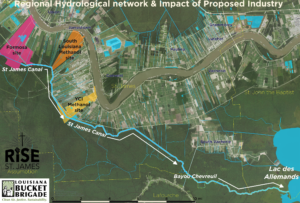
How Formosa Plastics Misled the St. James Parish Council
Three reasons why the Council has the power to stop Formosa Plastics
Formosa Plastics omitted key facts to win approval from the St. James Parish Council. These crucial facts were exposed only after Formosa Plastics received approval from the Council in 2019. These facts are grounds for the St. James Parish Council to rescind Formosa’s land use approval.
1. Lied About the Site Plan
Though Formosa told the Council that it had moved the most dangerous units away from an elementary school and a church, the company had in fact moved one of the most dangerous units – the ethylene glycol unit – closer to the school. Learn more here.

Above: Formosa site plan with distances from an active elementary school
2. Gravesites
Formosa discovered gravesites on its proposed site in July of 2018 but withheld this information from the Parish Council and the community throughout the land use approval process. Learn more here.

Above: Map of archaeological sites on & around the proposed Formosa Plastics site, including at least two plantation-era cemeteries.
3. Toxic Emissions
- Air: When the Council approved Formosa’s Land Use Permit, the parish had no idea that Formosa’s complex would double toxic air emissions in the parish and triple toxic air emissions in communities one mile east of the site.
- Water: Formosa Plastics has an extensive history of dumping toxic waste into waterways surrounding its facilities. In 2019, Formosa was labeled a “serial offender” for dumping billions of tiny plastic pellets, called nurdles, into waterways surrounding Point Comfort, TX. If Formosa builds in St. James, nurdles and storm water would flow from Formosa’s site directly into Lac des Allemands, known as the “Catfish Capital of the Universe.” This lake is a major source of catfish, shrimp, and crab sold throughout Louisiana and the country.

Above: The path of wastewater runoff from the Formosa Plastics site to Lac des Allemands.
TIMELINE
June 25th, 2018: Formosa submits its initial land use application to the Parish.
Late July, 2018: Formosa consultants are alerted by the Louisiana Division of Archaeology of two now confirmed burial grounds on its site. Formosa withholds this information from the parish.
October 19, 2018: Formosa submits a supplement to its land use application, stating that “after consultation and discussion with the Parish” it “revised its plot plan” and “relocated some of its units…farther away from the new church and school.” The supplement included the exact same plot plan Formosa submitted in June—Formosa revised nothing.
January 24, 2019: St. James Parish Council approves Formosa’s land use application with no knowledge that the site plan has been left unchanged, that gravesites were discovered on Formosa’s site, and that Formosa’s complex would double toxic emissions in the parish.
December 18, 2019: RISE St. James uncovers and releases information of gravesite discovery on Formosa Plastics’ site.
December 23, 2019: On behalf of RISE St. James, Earthjustice informs the St. James Parish Council that Formosa Plastics never reconfigured its site plan. The parish attorney’s defense of Formosa on January 21st, 2020 actually acknowledged Formosa’s site plan sleight of hand.
